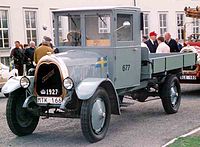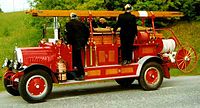Tidaholms Bruk
Automotive | |
| Headquarters | Tidaholm, Sweden |
|---|---|
Key people |
|
Tidaholms Bruk (the Tidaholm works) was a
Origins
Founded in the
Early vehicles
The first model was called Tor I and was powered by a two-cylinder engine producing about 10 hp at 800 rpm. It could carry 1.5 tonnes (3,300 lb) with a curb weight of 2.7 tonnes (6,000 lb). It was sold to Surte Glasbruk and was used to transport peat. The high reliability of the car inspired the managing director Victor Johansson to put Lindström in charge of building Tor II which was finished in 1905. Tor II had three gears forward and one reverse.[3] It was used for demonstrations at the country fair in Skara in 1905. By 1907–1910 the manufacturing had come so far that the works built a small series of ten chassis of type TB, a combined truck and personnel car, or open bus powered by a four-cylinder, German Fafnir engine, giving about 12 hp. Later, this was replaced with engines from Argus, with power ranging between 12 and 16 horsepower.[3] Four or six passenger cars were built in 1911 or 1912, the first probably using an imported German body. The second was a test car for a possible larger production. When Tidaholms Bruk folded in 1934 this car was sold to a blacksmith and its fate is unknown. The third car was exported to Russia and delivered to a Grand Duke in St Petersburg. The Thulin logo in the front was written in Cyrillic letters on that car. A fourth car was sold to firefighters in Uppsala.
In September 1914, the company changed hands, when it was purchased by a consortium headed by Josef Kastengren.[3] In 1915, Tidaholm started selling their trucks under the Castor brand. After a series of management changes, this brand was abandoned by 1919. In 1917 sales to the important Russian market came to an abrupt halt with the Russian Revolution and the company entered a period of decline. From 200 employees in 1917, the staff numbered in the low tens in 1921.[4] The lineup was reduced as demand dried up, leaving the 2.5–3 tonnes (5,500–6,600 lb) model as the only available one by 1918. Due to rubber shortages, the trucks were also delivered with wheels that could accommodate ersatz tires made from wood.[5] The company barely stayed afloat by operating a saw mill, exporting wooden revetments as far afield as France, but in 1922 an order for five fire trucks to Jönköping began a slow upswing in company fortunes.[4]
-
Tidaholm truck from 1907
-
Tidaholm mail truck from 1912
Later vehicles
Tidaholms Bruk also sold German
-
Tidaholm Fire Engine 1924
-
Tidaholm TSLO Bus 1925
-
Tidaholm TSL Truck 1927
-
Tidaholm Fire Engine 1927
-
Tidaholm T2C Fire Engine 1929
-
1933 Tidaholm T6L, three-axle sleeper truck
Closure
Tidaholms Bruk made well built engines and chassis and they sold well, but experiments and frequent new designs leading to small production runs cost a lot of money. The
See also
References
- ^ Chudi, Sixten (1956). "Tidaholms Bruks biltillverkning 1903–1933" [Automobile production at Tidaholms Bruk 1903–1933] (PDF). Dædalus (in Swedish). 26. Stockholm: Tekniska Museet: 101. Archived from the original (PDF) on 2023-10-31.
- ^ Sundfeldt, Björn (1991-01-24). "Då var det gyllene tider i Tidaholm" [It was a golden age in Tidaholm]. Teknikens Värld (in Swedish). Vol. 43, no. 2. Stockholm, Sweden: Specialtidningsförlaget AB. p. 42.
- ^ a b c d Sundfeldt 1991, p. 44.
- ^ a b Chudi 1956, p. 108.
- ^ "Castor" Lastbilar (in Swedish), Tidaholm, Sweden: Tidaholms Verks Aktiebolag, 1918, p. 2, archived from the original on 2023-10-27 – via National Library of Sweden
- ^ Chudi 1956, p. 117.
- ^ a b Sundfeldt 1991, p. 45.
- ISBN 91-85496-22-7.
- ^ Tidaholm, Cars/Sweden, Konditori 100s Garage








